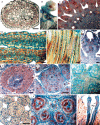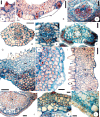Floral development and evolution of capitulum structure in Anacyclus (Anthemideae, Asteraceae)
- PMID: 23287557
- PMCID: PMC3828941
- DOI: 10.1093/aob/mcs301
Floral development and evolution of capitulum structure in Anacyclus (Anthemideae, Asteraceae)
Abstract
Background and aims: Most of the diversity in the pseudanthia of Asteraceae is based on the differential symmetry and sexuality of its flowers. In Anacyclus, where there are (1) homogamous capitula, with bisexual, mainly actinomorphic and pentamerous flowers; and (2) heterogamous capitula, with peripheral zygomorphic, trimerous and long-/short-rayed female flowers, the floral ontogeny was investigated to infer their origin.
Methods: Floral morphology and ontogeny were studied using scanning electron microscope and light microscope techniques.
Key results: Disc flowers, subtended by paleae, initiate acropetally. Perianth and androecium initiation is unidirectional/simultaneous. Late zygomorphy occurs by enlargement of the adaxial perianth lobes. In contrast, ray flowers, subtended by involucral bracts, initiate after the proximal disc buds, breaking the inflorescence acropetal pattern. Early zygomorphy is manifested through the fusion of the lateral and abaxial perianth lobes and the arrest of the adaxials. We report atypical phenotypes with peripheral 'trumpet' flowers from natural populations. The peripheral 'trumpet' buds initiate after disc flowers, but maintain an actinomorphic perianth. All phenotypes are compared and interpreted in the context of alternative scenarios for the origin of the capitulum and the perianth identity.
Conclusions: Homogamous inflorescences display a uniform floral morphology and development, whereas the peripheral buds in heterogamous capitula display remarkable plasticity. Disc and ray flowers follow different floral developmental pathways. Peripheral zygomorphic flowers initiate after the proximal actinomorphic disc flowers, behaving as lateral independent units of the pseudanthial disc from inception. The perianth and the androecium are the most variable whorls across the different types of flowers, but their changes are not correlated. Lack of homology between hypanthial appendages and a calyx, and the perianth double-sided structure are discussed for Anacyclus together with potential causes of its ray flower plasticity.
Keywords: Anacyclus; Compositae; capitulum; disc flowers; evo-devo; inflorescence; pseudanthium; ray flowers.
Figures









References
-
- Anderson LC, Hartman RL, Stuessy TF. Morphology, anatomy, and taxonomic relationships of Otopappus australis (Asteraceae) Systematic Botany. 1979;4:44–56.
-
- Andersson S. The genetic basis of floral variation in Senecio jacobea (Asteraceae) Journal of Heredity. 2001;92:409–414. - PubMed
-
- Andersson S. Pollinator and nonpollinator selection on ray morphology in Leucanthemum vulgare (oxeye daisy, Asteraceae) American Journal of Botany. 2008;95:1072–1078. - PubMed
-
- Bremer K, Humphries C. Generic monograph of the Asteraceae-Anthemidae. Bulletin of the Natural History Museum of London (Botany) 1993;23:71–177.
Publication types
MeSH terms
LinkOut - more resources
Full Text Sources
Other Literature Sources

